
 This edition published in 2003 by Red Wheel/Weiser, LLC York Beach, ME With offices at: 368 Congress Street Boston, MA 02210 www.redwheelweiser.com Text Copyright 1995 Dorothy Kelly Foreword Copyright 2003 Red Wheel/Weiser All rights reserved. No part of this publication may be reproduced or transmitted in any form or by any means, electronic or mechanical, including photocopying, recording, or by any information storage and retrieval system, without permission in writing from Red Wheel/Weiser, LLC. Reviewers may quote brief passages. First published in 1995. Cataloging-in-Publication Data available upon request from the Library of Congress. ISBN 1-57863-293-5 Tarot cards reproduced in the text and on the cover are from the Universal Waite Tarot Deck, Copyright 1991 U.S.
This edition published in 2003 by Red Wheel/Weiser, LLC York Beach, ME With offices at: 368 Congress Street Boston, MA 02210 www.redwheelweiser.com Text Copyright 1995 Dorothy Kelly Foreword Copyright 2003 Red Wheel/Weiser All rights reserved. No part of this publication may be reproduced or transmitted in any form or by any means, electronic or mechanical, including photocopying, recording, or by any information storage and retrieval system, without permission in writing from Red Wheel/Weiser, LLC. Reviewers may quote brief passages. First published in 1995. Cataloging-in-Publication Data available upon request from the Library of Congress. ISBN 1-57863-293-5 Tarot cards reproduced in the text and on the cover are from the Universal Waite Tarot Deck, Copyright 1991 U.S.
Games Systems, Inc. Used by kind permission of U. S. Games Systems, Inc., Stamford, CT 06902. Further reproduction is prohibited. Typeset in 10 pt.
Palatino Printed in the United States of America Victor Graphics 10 09 08 07 06 05 04 03 8 7 6 5 4 3 2 1 The paper used in this publication meets the minimum requirements of the American National Standard for Information SciencesPermanence of Paper for Printed Library Materials Z39.48-1992 (R1997). www.redwheelweiser.com/newsletter
Table of Contents
Basic Definitions Combining the Major Arcana The Wands Combining Wands The Cups Combining Cups The Swords Combining Swords The Pentacles Combining of Pentacles Combining Two Cards Combining Three Cards Combining Four Cards Introduction Example
Foreword
I can still remember the day some years ago when I first came across Dorothy Kelly's
Tarot Card Combinations. I was standing in front of the tarot section of my favorite bookstore looking through the possibilities when I spied this new entry to the tarot canon. My hand shot out. Now, here's the book I've been looking for! When you're first learning the tarot, you naturally devote your time to absorbing the basics. You study how your deck is put together and how to lay out a reading. You work hard to become familiar with each of the 78 cardsa major undertaking.
But once you know the fundamentals, you're ready to move to a deeper level of tarot work. You need to learn how to relate the cards to each other, but when you look for help, you discover there isn't too much written or taught about this all-important step. Tarot Card Combinations is one of those rare books devoted to the connections between cards, not just the cards themselves. Kelly offers us an approach to card relationships written in a straightforward, practical style. There are no flights of fancy or esoteric meanderings herejust a clear and useful plan for making sense of card interactions. Kelly's system is based on keyword meanings.
She offers about twelve for each cardsix that apply when upright, six when reversed. New tarot students can adopt Kelly's keywords directly, but experienced readers can modify them or substitute their own meanings instead. To interpret a card combination, you take one keyword for each card and combine the two into a single phrase. For example, one keyword meaning for The Hermit is Solitude; one for The Wheel of Fortune is Change. So, one interpretation of the Hermit-Wheel of Fortune combination might be Solitude brings Change. Direction is important, so a Wheel of Fortune-Hermit pair would generate a different possibilityperhaps Change brings Solitude.
You can create longer story lines by linking three or four cards. Add the Five of Cups (loss) and King of Wands (adult male) to our example, and the result will be a new, more detailed phrase. One possibility is: Solitude brings Change due to Loss of a Male Partner. This technique works for all kinds of readings, but it's especially effective when combined with spreads that feature groups of cards. Kelly describes several of these, including the intriguing Twenty-Eight Card Spread with seven sets of four-card combinations. At first glance, Kelly's approach might seem somewhat artificial.
You take one keyword from Column A and one from Column B and mix. There doesn't appear to be much room for intuition in such a scheme. In practice, though, Kelly's system blends rigor and intuition beautifully. The mechanism may be fixed, but you draw on your intuition to choose the most appropriate keywords. You work with a set pool of meanings, but knowing the one that fits best in any given moment is up to you. Within the tarot community, there is a running argument (usually friendly) about the ideal role of the tarot reader.
Some believe the reader should stay out of the interpretation business altogether. She should simply present card meanings without elaboration to avoid corrupting their message with personal bias. The cards must be allowed to speak for themselves. Other readers believe card meanings should be fluid and individual. They see the reader as taking a more active role. He receives the message of the cards by opening to an inner source of wisdom.
Guidance is triggered by the cards, but often goes beyond them. I have to admit I fall into this latter group. My predilection is to see the cards as points of departure. They help you open to knowledge that is based on the cards, but is not limited to them. Readings open an inner door so guidance from a Greater Source can come through. This flow will be unique for each reader and each reading.
What is unusual about Tarot Card Combinations is that it works with both these reading styles. It offers support for each point of view. Readers who prefer to let the cards do the talking will appreciate Kelly's well-defined instructions for generating clear interpretations. But they will also discover how to bring intuition into play without too much risk. Readers who embrace a fluid style of interpretation will be able to appreciate the role of intuition, but also have the chance to explore the benefits of fixed keywords. Purely intuitive readings can sometimes drift too far from the cards and become vague and wispy.
Having a firm set of known meanings to draw on provides a welcome grounding. As you glance through this book, you may be a little daunted by the many pages devoted to specific card combinations. You might wonder, Will I have to memorize all these card pairs? Will I need to refer to this book every time I want to interpret a combination? The answer to both questions is no. Tarot Card Combinations is a teaching tool with valuable insights into the art of blending cards together. The many combinations simply illustrate this process in detail for you. By studying the examples and seeing how they relate to individual card meanings, you will be able to absorb the technique and apply it to your own tarot practice.
The idea that readings are stories has always been a central element of my own work with the cards. I feel as if I have found a kindred spirit in Dorothy Kelly. She clearly recognizes that tarot wisdom is often most meaningful when presented in the form of a personal tale. Creating a story from the cards is the ideal way to uncover a reading's deepest meaning. The story-making art can't be taught directly, but it can be developed through patient practice and experience. You will find Tarot Card Combinations a worthwhile companion to keep at your side as you discover your own tarot stories.
Joan Bunning
February 2003
Preface
This book is a guide to reading the tarot. I have provided basic definitions of the meanings of the cards so that, if you are just starting to study the tarot, you can quickly see how the cards can tell the story of the lives of the people around you. The interpretations cover single meanings of both upright and reversed cards, as well as examples of card combinations to show how to link up two, three, or four cards. Using this system, you can learn to identify and separate various groupings of cards that relate to stories concerning money, relationships, problems, health, and so forth. Examples of certain card combinations will indicate particular questions and outcomes relating to those questions. Events and influences surrounding particular questions are also shown in layouts that demonstrate how to use different tarot spreads.
Next page
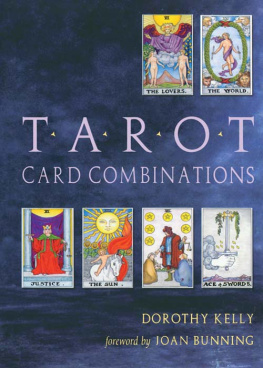
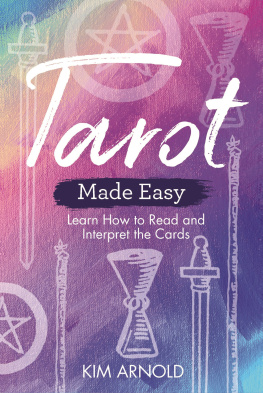

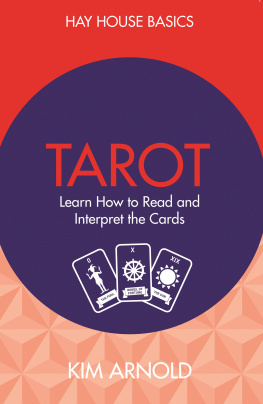
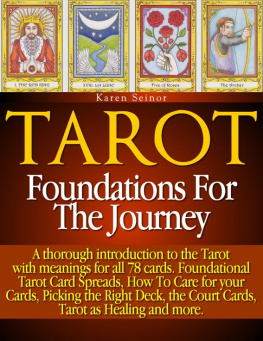

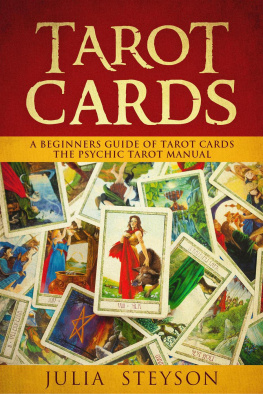

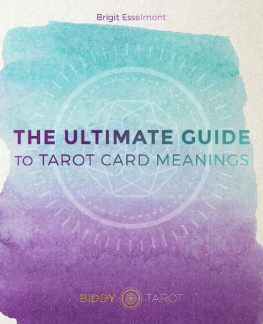
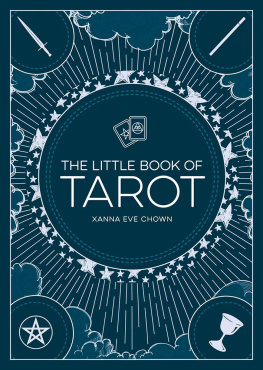


 This edition published in 2003 by Red Wheel/Weiser, LLC York Beach, ME With offices at: 368 Congress Street Boston, MA 02210 www.redwheelweiser.com Text Copyright 1995 Dorothy Kelly Foreword Copyright 2003 Red Wheel/Weiser All rights reserved. No part of this publication may be reproduced or transmitted in any form or by any means, electronic or mechanical, including photocopying, recording, or by any information storage and retrieval system, without permission in writing from Red Wheel/Weiser, LLC. Reviewers may quote brief passages. First published in 1995. Cataloging-in-Publication Data available upon request from the Library of Congress. ISBN 1-57863-293-5 Tarot cards reproduced in the text and on the cover are from the Universal Waite Tarot Deck, Copyright 1991 U.S.
This edition published in 2003 by Red Wheel/Weiser, LLC York Beach, ME With offices at: 368 Congress Street Boston, MA 02210 www.redwheelweiser.com Text Copyright 1995 Dorothy Kelly Foreword Copyright 2003 Red Wheel/Weiser All rights reserved. No part of this publication may be reproduced or transmitted in any form or by any means, electronic or mechanical, including photocopying, recording, or by any information storage and retrieval system, without permission in writing from Red Wheel/Weiser, LLC. Reviewers may quote brief passages. First published in 1995. Cataloging-in-Publication Data available upon request from the Library of Congress. ISBN 1-57863-293-5 Tarot cards reproduced in the text and on the cover are from the Universal Waite Tarot Deck, Copyright 1991 U.S.